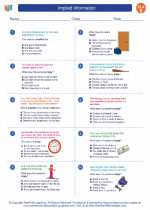Implied Information
Implied information is information that is suggested or inferred but not directly stated. It requires the reader to make connections and draw conclusions based on the context and clues provided in the text.
Examples of Implied Information
- When a character in a story is described as "nervous" and "fidgety," the implied information is that the character may be anxious or worried about something.
- If a passage describes a dark, stormy night and a creaking sound coming from the attic, the implied information is that something eerie or mysterious may be happening.
- When a character says, "I can't believe you did that," the implied information is that the character is upset or disappointed with the other person's actions.
How to Identify Implied Information
To identify implied information in a text, look for clues such as descriptive language, characters' actions and reactions, and the overall tone and mood of the passage. Pay attention to what is not directly stated but can be inferred from the words and details provided.
Why Implied Information Matters
Understanding implied information is important because it allows readers to engage with the text on a deeper level, making inferences and drawing conclusions that enhance their comprehension and analytical skills.
Study Tips
When reading a passage, pay close attention to descriptive language, characters' behavior, and the overall atmosphere to identify implied information. Practice making inferences based on the clues provided, and discuss your interpretations with others to strengthen your understanding of implied information.
[Implied Information] Related Worksheets and Study Guides:
.◂English Language Arts Worksheets and Study Guides Fifth Grade. Implied Information

 Worksheet/Answer key
Worksheet/Answer key
 Worksheet/Answer key
Worksheet/Answer key
